One of the first decisions you’ll likely have to make when choosing steam humidification for a commercial or industrial application is whether to select a resistive steam humidifier or electrode steam humidifier. Both units differ from one another in several key areas, including:
- The method of heating water to produce steam
- The level of close control required
- Maintenance requirements
- Water quality at site location
- Importance of capital or consumable costs
What is an Electrode Steam Humidifier?
Electrode boiler or electrode steam humidifiers heat water by transmitting an alternating current between electrodes within a plastic cylinder, using the ions dissolved (minerals) in the water for conduction. Mains water (which contains minerals) will conduct electricity between the electrodes with significant resistance. This will heat the water to boiling point and produce steam to add moisture and increase humidity levels.
The capacity of the unit is determined by the size of the cylinder, the surface area of the electrodes in contact with the water, and the humidifier’s rated power (kW). It’s method of regulating the steam output involves changing the level of water inside the cylinder. The more of the electrode surface that is submerged the more current will flow between them. This increases the amount of power used and increases the overall steam generation. Lowering the water level will result in a decrease in steam production.
As mains water turns into steam within the boiling chamber, all of the water supply ions left behind within the tank will eventually form as scale. Periodic cylinder cleaning will reduce the build-up, but over time the scale will build up to a point where the electrodes get worn and coated. Making them unable to provide maximum capacity. At this point, the cylinder needs to be exchanged, which is quick and easy to do as a consumable item.
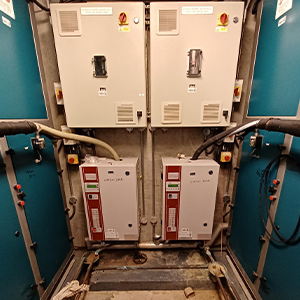
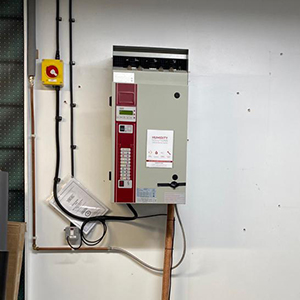
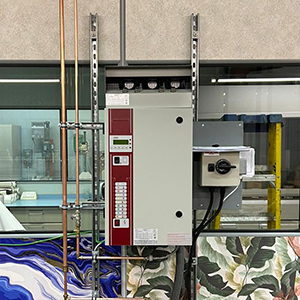
What is a Resistive Humidifier?
Resistive humidifiers differ by generating its steam production within a stainless-steel evaporation chamber. This chamber uses a self-cleaning heating elements to heat water to boiling point using electricity. Regardless of the water’s ion concentration, this radiant heating will elevate the temperature of the water inside the evaporation chamber to boiling point, enabling equal performance. Unlike the electrode boiler, a resistive unit does not rely on the minerals in the water to generate heat. This means that the resistive humidifier can operate off a purified reverse osmosis water supply which can reduce maintenance.
The accumulation of scale inside an evaporation chamber is reduced in resistive humidifier installations as they can perform regular flush cycles to help expel the minerals left behind. Without water treatment the humidifier will require regular cleaning of the evaporation chamber. As the chamber / cylinder is made of stainless steel consumables are less but labour time may be greater.
Depending on the mineral content of the water, these drain cycles may be decreased or abolished when using pure water. When being fed pure, or reverse osmosis water, the regular drain cycle turned off and the feed water can be changed to a trickle-feed setting. This means the boiling point is never lost within the boiling chamber. This ensures even closer control, as well as lowering the strain on internal components and maintenance requirements. Dependent on the control of the temperature into which the humidity is being added and the sensitivity of the controlling sensor, the humidifier is able to achieve +/- 1% relative humidity when applications demand this level of control.

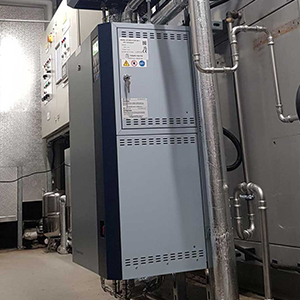
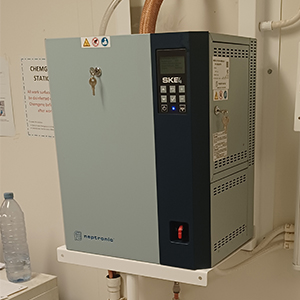
Distribution of Steam
In both types of units, steam is introduced into the Air Handling Units (AHU) or duct by stainless steel steam lances, sized to ensure good evaporation of steam into the airflow. For those retrofit applications where space is tight, or where the AHU section needs to be kept to a minimum, a multi-steam steam distribution manifold can be used to ensure the shortest evaporation distance is achieved – with these systems, it is possible to evaporate 100kg/hr of steam in less than 300mm of duct.
Neptronic’s Multi-Steam dispersion system is a high-efficiency steam distributor that ensures wasted energy is reduced by up to 85%. This is achieved by reducing condensate in the steam lances. Condensate is generated by the steam hitting a cooler surface creating condensate water which in many situations is sent to drain. This water had been heated to 100oC so to allow it to be sent to drain would waste energy. The multi lances ensure that these losses are kept to a minimum creating savings over more standard installations. This efficiency can be further enhanced with optional insulated channels.
For those in-room applications such as digital print rooms or small test labs, a specifically designed fan head can be installed on top of the humidifier, or remotely, to disperse the steam directly into the space.
Both steam humidification technologies can use these methods of steam dispersion.
Industrial or Commercial Steam Humidification?
Given humidity’s noted impact of employee wellbeing and indoor air quality, it’s no surprise that commercial humidifiers are growing in popularity. Offices and shops which are interested in improving conditions for employees and customers, lowering sick rates and ensuring product quality right up to the point of sale will want to consider one of the commercial humidification models we have available. Industrial humidifiers tend to be larger, heavier models which can reach more demanding relative humidity levels and provide closer climate control, but may run more loudly and require more upkeep due to their enhanced performance.
Right-sizing your humidification solution helps lower running costs and helps prevent unexpected costs through over-strained machinery. Talk to one of our experts for specialist advice and a turnkey solution to your humidity needs.
Which Kind of Steam Humidification is Right For Me?
Selection should be based on the application requirements. For example: Is it a comfort application or a manufacturing process requiring 24-hour control?
Is close control required or nice to have? Would you prefer higher capital costs or ongoing running costs? Is treated water available? All these factors and more are considered when selecting the correct technology to use in each specific application. In many cases, steam humidifiers are indeed the right choice and the best-engineered solution for a project.
As a rule of thumb electrode boilers are perfect for comfort and general air conditioning applications. Whereas the resistive technology is suited to laboratory or cleanroom applications. As always, it is best to consult humidity control specialists to determine the best solution for each unique application.
At Humidity Solutions, we stock Electrode Boilers and Resistive Humidifiers from market leaders in the industry. Our Electrode Boiler Steam Humidifiers are manufactured in the UK by Vapac, offering the quickest lead times in the industry. Our Resistive Steam Humidifiers are supplied by Neptronic, based in Montreal, Canada.
Contact us today to find out more about these units and find out why they are perfect for a variety of different industry applications. Call on 01372 571 200, email us at info@humiditysolutions.co.uk or even talk to us on live chat.



